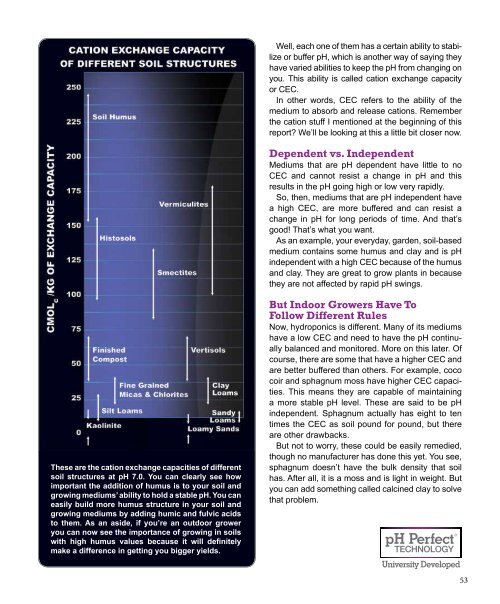You also want an ePaper? Increase the reach of your titles
YUMPU automatically turns print PDFs into web optimized ePapers that Google loves.
These are the cation exchange capacities of different<br />
soil structures at pH 7.0. You can clearly see how<br />
important the addition of humus is to your soil and<br />
growing mediums’ ability to hold a stable pH. You can<br />
easily build more humus structure in your soil and<br />
growing mediums by adding humic and fulvic acids<br />
to them. As an aside, if you’re an outdoor grower<br />
you can now see the importance of growing in soils<br />
with high humus values because it will definitely<br />
make a difference in getting you bigger yields.<br />
Well, each one of them has a certain ability to stabilize<br />
or buffer pH, which is another way of saying they<br />
have varied abilities to keep the pH from changing on<br />
you. This ability is called cation exchange capacity<br />
or CEC.<br />
In other words, CEC refers to the ability of the<br />
medium to absorb and release cations. Remember<br />
the cation stuff I mentioned at the beginning of this<br />
report? We’ll be looking at this a little bit closer now.<br />
Dependent vs. Independent<br />
Mediums that are pH dependent have little to no<br />
CEC and cannot resist a change in pH and this<br />
results in the pH going high or low very rapidly.<br />
So, then, mediums that are pH independent have<br />
a high CEC, are more buffered and can resist a<br />
change in pH for long periods of time. And that’s<br />
good! That’s what you want.<br />
As an example, your everyday, garden, soil-based<br />
medium contains some humus and clay and is pH<br />
independent with a high CEC because of the humus<br />
and clay. They are great to grow plants in because<br />
they are not affected by rapid pH swings.<br />
But Indoor Growers Have To<br />
Follow Different Rules<br />
Now, hydroponics is different. Many of its mediums<br />
have a low CEC and need to have the pH continually<br />
balanced and monitored. More on this later. Of<br />
course, there are some that have a higher CEC and<br />
are better buffered than others. For example, coco<br />
coir and sphagnum moss have higher CEC capacities.<br />
This means they are capable of maintaining<br />
a more stable pH level. These are said to be pH<br />
independent. Sphagnum actually has eight to ten<br />
times the CEC as soil pound for pound, but there<br />
are other drawbacks.<br />
But not to worry, these could be easily remedied,<br />
though no manufacturer has done this yet. You see,<br />
sphagnum doesn’t have the bulk density that soil<br />
has. After all, it is a moss and is light in weight. But<br />
you can add something called calcined clay to solve<br />
that problem.<br />
53


